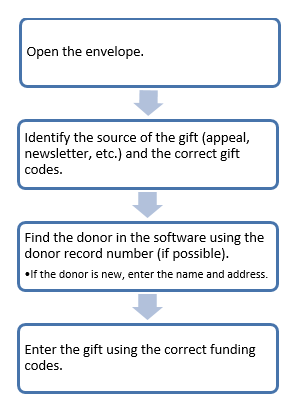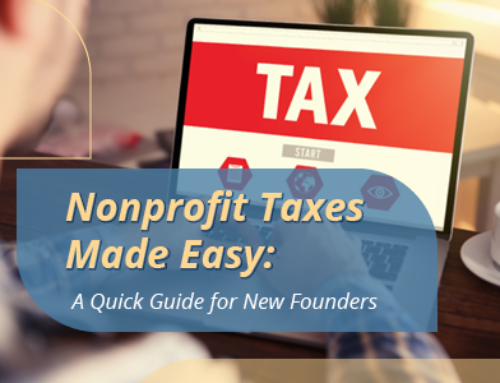 When you work in a small office, it’s tough to get everything done. And easy to get overwhelmed.
When you work in a small office, it’s tough to get everything done. And easy to get overwhelmed.
Every big nonprofit you can think of was once a small shop, with someone doing most everything themselves.
So, how did they grow from a tiny little nonprofit to a much bigger one?
It’s the same way that businesses grow and the back bone of franchises.
Think for a minute about Starbucks.
If you go to any Starbucks in the world and order a tall vanilla latte, you’re going to get the same drink no matter what city you’re in.
Know why?
Systems.
Systems will save you.
The magic of fundraising systems
 Systems help you grow and multiply your efforts.
Systems help you grow and multiply your efforts.
When you have a system for getting something done, you don’t have to think too hard about what you’re doing.
You follow the formula and get the result you’re looking for. Just like that tall vanilla latte.
A system is simply an organized method for accomplishing a task so that you get the same result every time, no matter who is using the system.
Actually, the system can run without you, because someone else can easily follow it.
Systems can help you be more efficient, ensure quality and speed up the training process for new folks.
The biggest reason why you need systems in your fundraising office is that they help you get more done.
Face it, you’re just one person and you can’t do everything (even if you try).
Fundraising systems will streamline your work and save you time.
I see people all the time who have no systems or their systems are broken. They’re overwhelmed, they spend a lot of time ‘winging it’, they’re disorganized, and they seem to always be fighting fires.
In practical terms, when you don’t have systems, you won’t be able to keep good volunteers – they’ll get frustrated at the disorganization and go somewhere else. Your database will be crap because you’re inconsistent about entering data and there’s no protocol for keeping it clean. Donors will be frustrated at the errors in your materials or the sporadic nature of your communications.
Anything you do more than once needs a system. Theoretically, every time you use the system, you get faster or you refine it. You become more efficient.
Systems are best when:
- They are in writing.
- They are clearly understood by those who will be using them.
- They are reviewed from time to time to make sure they still work.
Steps to creating a system
When you’re ready to create a new system, follow these steps:
1. Identify the end result. What is the result you want from the system every time it’s used, no matter who is using it?

2. Identify system users. Who will be using the system? What do they know now about the end result you’re trying to achieve? What training and support will they need?
3. Flowchart the system. Break the system down into small, separate steps that will be easy to understand and teach. Flowcharts give you a nice easy visual to work with, and you can do this with software (there’s a SmartArt tool in most Microsoft products) or sticky notes.
4. Create system support tools. What can you create that will help the user? Think about checklists, worksheets, forms, etc., that can make learning and using the system easier.
Here’s an example of a system flow chart for entering gifts that are received through the mail. It’s pretty simple yet effective.
I personally would create a procedure for this system with screen shots of the donor tracking software for looking up a donor, entering a new donor, and entering the gift. I’d create a list of gift codes for easy reference. And I’d create a separate system for creating a new donor record, with specifics about what information goes in what field, whether pieces of the address should be abbreviated or not, and what salutations should be set up.
Yes, it may seem like a lot of detail, but that’s what will set you up for success long-term. You have your way of doing things, and if you want others to do it your way, you have to systematize it. Then it becomes the organization’s way of doing things.
10 must-have fundraising systems for the small nonprofit
After working in fundraising for nearly 20 years, I’ve found that these are the systems you absolutely must have if you want to raise more money in the coming year.
Warning: don’t try to create all these systems at once. Start with the one that will give you the most leverage, create it and put it in place. Once it seems to be working well, go on to the next one. If you tackle one system a month and you get it solidly in place, you will see tremendous improvement over the next 12 months.
Once you have systems created and begin using them, review them from time to time to make sure they still work. Ask those who use the system for feedback. Check the system output to make sure you’re still getting the results you’re looking for. Update your procedures. And make sure everyone is still on the same page about what the system should be doing.


 2. Volunteer onboarding. The more you spread the word about your nonprofit’s good work, the more people will want to help. You need a system for recruiting volunteers or responding to inquiries (be prepared for both phone and email inquiries), how you store volunteer information including their areas of interests and times of availability, and how you get them oriented and plugged in.
2. Volunteer onboarding. The more you spread the word about your nonprofit’s good work, the more people will want to help. You need a system for recruiting volunteers or responding to inquiries (be prepared for both phone and email inquiries), how you store volunteer information including their areas of interests and times of availability, and how you get them oriented and plugged in. 5. Social media. This system should include how you decide what to post, when to post, where to post, and who posts. Getting clear about this system will save you a ton of time and keep you from staring at Facebook wondering what you should be sharing. It will also keep your audience interested and more engaged.
5. Social media. This system should include how you decide what to post, when to post, where to post, and who posts. Getting clear about this system will save you a ton of time and keep you from staring at Facebook wondering what you should be sharing. It will also keep your audience interested and more engaged. 8. Creating a newsletter. Your newsletter can be your best tool for building relationships with donors and prospects, but if it’s done haphazardly, it won’t accomplish much of anything (and unfortunately, most nonprofit newsletters are crap). Create a system for the timing of your newsletter (when it goes out and how often it goes out), its format, its content, and who it goes to. When you have a schedule and an editorial calendar for your newsletter, writing it becomes much, much easier, and your recipients will actually read it!
8. Creating a newsletter. Your newsletter can be your best tool for building relationships with donors and prospects, but if it’s done haphazardly, it won’t accomplish much of anything (and unfortunately, most nonprofit newsletters are crap). Create a system for the timing of your newsletter (when it goes out and how often it goes out), its format, its content, and who it goes to. When you have a schedule and an editorial calendar for your newsletter, writing it becomes much, much easier, and your recipients will actually read it!




Leave A Comment